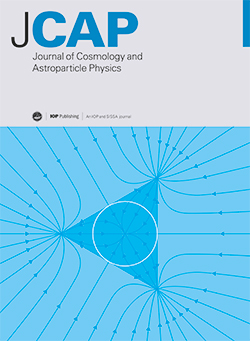Hamiltonian formalism for cosmological perturbations: fixing the gauge
IF 5.3
2区 物理与天体物理
Q1 ASTRONOMY & ASTROPHYSICS
Journal of Cosmology and Astroparticle Physics
Pub Date : 2025-01-21
DOI:10.1088/1475-7516/2025/01/083
引用次数: 0
Abstract
Cosmological perturbation theory is an example of a gauge theory, where gauge transformations correspond to changes in the space-time coordinate system. To determine physical quantities, one is free to introduce gauge conditions (i.e. to work with specific space-time coordinates), and such conditions are often used to simplify technical aspects of the calculation or to facilitate the interpretation of the physical degrees of freedom. Some of the prescriptions introduced in the literature are known to fix the gauge only partially, but it is commonly assumed that the remaining gauge degrees of freedom can be fixed somehow. In this work, we show that this is not necessarily the case, and that some of these gauges are indeed pathological. We derive a systematic procedure to determine whether a gauge is pathological or not, and to complete partially-fixed gauges into healthy gauges when this is possible. In this approach, the Lagrange multipliers (i.e. the perturbed lapse and shift in the ADM formalism) cannot appear in the off-shell definition of the gauges, they necessarily arise as on-shell consequences of the gauge conditions. As illustrative applications, we propose an alternative, non-pathological formulation of the synchronous gauge, and we show that the uniform-expansion gauge (as well as any gauge ensuring vanishing lapse perturbations) can hardly be made healthy. Our methodology also allows us to construct all gauge-invariant variables. We further show that our non-pathological criterion for gauges is also the one that ensures Dirac brackets to be properly defined. This allows cosmological perturbations to be quantised in a gauge-fixed way. We finally discuss possible generalisations of our formalism.宇宙学微扰的哈密顿形式论:固定规范
宇宙微扰理论是规范理论的一个例子,规范变换对应于时空坐标系的变化。为了确定物理量,人们可以自由地引入规范条件(即与特定的时空坐标一起工作),这些条件通常用于简化计算的技术方面或促进对物理自由度的解释。已知文献中引入的一些处方只能部分地固定规范,但通常假设剩余的规范自由度可以以某种方式固定。在这项工作中,我们表明情况并非如此,其中一些指标确实是病态的。我们推导了一个系统的程序来确定一个量规是否病态,并在可能的情况下将部分固定的量规完成为健康的量规。在这种方法中,拉格朗日乘数(即ADM形式中的扰动失效和位移)不能出现在量规的壳外定义中,它们必然作为量规条件的壳上结果出现。作为说明应用,我们提出了一种替代的、非病态的同步规范,并且我们证明了均匀膨胀规范(以及任何保证消失的失效扰动的规范)很难是健康的。我们的方法也允许我们构造所有的尺度不变变量。我们进一步证明了我们的非病理判据也是确保狄拉克括号被正确定义的判据。这使得宇宙学的扰动可以用一种固定尺度的方式量子化。最后,我们讨论形式主义可能的概括。
本文章由计算机程序翻译,如有差异,请以英文原文为准。
求助全文
约1分钟内获得全文
求助全文
来源期刊

Journal of Cosmology and Astroparticle Physics
地学天文-天文与天体物理
CiteScore
10.20
自引率
23.40%
发文量
632
审稿时长
1 months
期刊介绍:
Journal of Cosmology and Astroparticle Physics (JCAP) encompasses theoretical, observational and experimental areas as well as computation and simulation. The journal covers the latest developments in the theory of all fundamental interactions and their cosmological implications (e.g. M-theory and cosmology, brane cosmology). JCAP''s coverage also includes topics such as formation, dynamics and clustering of galaxies, pre-galactic star formation, x-ray astronomy, radio astronomy, gravitational lensing, active galactic nuclei, intergalactic and interstellar matter.
 求助内容:
求助内容: 应助结果提醒方式:
应助结果提醒方式:


